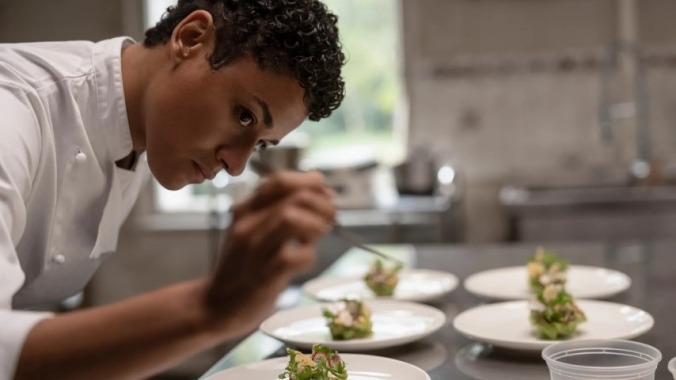The Conceited House of Spoils Resents Its Horror Film Assignment
Photos via Amazon Prime Video
If I rolled up to a group of horror geeks months ago and challenged them to guess which studio was producing a film with the premise of “haunted restaurant,” I have utter faith that after mulling it over for a few seconds, the answer would invariably come back: Blumhouse. And they would of course be correct–it doesn’t take all that much media savvy to assume that the company producing movies like Night Swim, with its groundbreaking “haunted swimming pool” storyline, would then take a glance at The Bear or The Menu and think “…but what if it had a ghost?” A cliché, by-the-numbers horror flick set in a fine dining restaurant feels right on par for Jason Blum’s company … and yet House of Spoils is oddly not really that film. Rarely does it ever genuinely feel like a horror movie at all, in fact. Instead, it’s more like a halfhearted feminist kitchen drama, with the occasional “scary” beat inserted under protest, a horror film via technicality of labeling and marketing rather than any particular intent. It wants to be just about anything but.
House of Spoils comes to us from writer-director duo Bridget Savage Cole and Danielle Krudy, who can’t be blamed for recognizing that the horror genre is one of our most effective pathways for young filmmakers to gain exposure and break through to decently budgeted productions. Why else infuse such tepid supernatural spooks into a story about a young, nameless chef (played by Oscar winner Ariana DeBose) risking her career to open her dream restaurant, a destination farm-to-table concept in the woods? The reality is that the film Cole and Krudy most likely wanted to make–a more realistic dramedy about the struggles of getting such a project underway, ‘ala The Bear–probably would have been more engaging (or at least more coherent) than the tonal mishmash we instead receive. This thing has been sliced, diced and pounded into submission.
Because there are some semi-promising moments of satire here, at least in the early going. It captures some brief impressions of the decadence of hoity-toity chefs and restaurant execs who want to appear culturally literate and respectful, even as they cannibalize other cultures to find the next greatest thing in haute cuisine. It’s the first film I’ve seen namedrop a traditional Mexican spirit like the mezcal-based pechuga, which is traditionally made by hanging an entire chicken or rabbit above the still during distillation, letting the cooked fat and juices drip into the liquid before it is distilled again. Naturally, it’s the douchey chef-financier who pulls out the bottle of the traditionally celebratory Mexican spirit, just one more little theft among what has clearly been many in his career.
But as soon as DeBose arrives at the crumbling structure in the woods–is it a compound, a house, a former school?–that will be her new restaurant, any brief ounce of subtlety instantly drops away, replaced by a torrent of well-worn clichés. Doors start blowing open and slamming. Motionless figures are briefly spotted among the treeline. She immediately finds a left-behind journal from the project’s previous chef, but somehow misses until 45 minutes of runtime later that the back half of said journal is entirely filled with spooky, repetitive drawings. I’m almost surprised that last chef (who eventually dramatically reappears) didn’t also write “HELP ME” or “HAUNTED RESTAURANT” in block letters for the audience’s benefit. House of Spoils takes its time, and then some, telling you what you already know–the place has bad juju. It’s purportedly because the former resident was a witch, if you were wondering.
DeBose’s nameless protagonist is of course an unreliable narrator of the sort that is also consistent for the genre. She’s burdened at least somewhat by the unrelenting pressure of the professional kitchen environment she has endured in the years leading up to this, her “big break,” and the script clumsily falls back on one of my favorite horror clichés to communicate this: Every now and then, we see her downing a handful of pills. No elaboration on what those pills would be, or commentary from any other character, all of whom are oblivious. Just, you know … pills. People who take “pills” in a movie have untrustworthy perception, as you may know. People who take pills in a horror movie, meanwhile, are clearly destined to take more and more of them as their mental condition erodes, angrily arguing with themselves that no, this all cannot be happening. Such is the law for a film like House of Spoils, which offers no rebuttal.
-

-

-

-

-

-

-

-

-

-

-

-

-

-

-

-

-

-

-

-

-

-

-

-

-

-

-

-

-

-

-

-

-

-

-

-

-

-

-

-








































